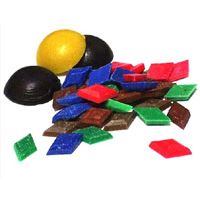

What do you want to know about candle making?
candle making colours 

I use small candle making dye chips. They come in a packet of 8 chips. Each chip colours about 1/2 kilo ( 1 pound of wax.)
Use more chips for deeper colours. I think I have seen about 30 shades for sale, and then you can get endless variety by
mixing them for custom colour making! Dye also comes in liquid form, powder form and larger cake form and flake form.
Chips are premeasured and make it easier for you to match your colour batches. candle making scents Liquid candle making scents are available in 15 ml (1/2 oz) and larger bottles. One supplier recommends 15 ml for 1/2 kilo
of wax (1/2 oz for 1 pound). Scent strength does vary according to the formulation - check with your supplier to find out
what quantity to use with wax. I have had some problems using essential oils not specifically made for candles. They did not mix well with the melted wax,
leaving pitting and bubbles and mottling on the candle's finish and an oily residue weeping from the candle surface. You may
desire this effect in a rustic type candle. If in doubt, check with your supplier to make sure that their formulation will mix
with wax. It depends on the type of carrier oil used in the scent. There must be no water or alcohol in the scent. I have used ground cinnamon, added to the melted wax just before pouring. You have to stir very well, and it still tends to
settle in the bottom of your mould, but that effect is nice in a rustic style candle. Try other aromatic spices! Check below for
instructions on hurricane candles to get an outer candle layer filled with herbs or other materials. I have also added crushed and whole lavender flowers. They settle too, in a mould or container but the effect was attractive.
And they add a wonderful aroma to a candle. Sometimes people have trouble with the scent 'throw' of their candles when they use too much vybar as a wax additive. It
binds up the scent oil molecules Also, if you are buying a paraffin blend, it may already have vybar added to it. Blends
sometimes are known as 'one pour' wax. Add your scent to the melted paraffin just before pouring, so it won't evaporate with a lot of cooking. for container candles: Use 125-130 degree fahrenheit melt point paraffin - that is 50 - 55 degrees Celsius (low melt point) The vybar allows you to use more liquid scent than you are using presently. It binds up the molecules of scent oil so they
don't 'bleed' out of your finished candles in oily droplets or residue at the bottom of the candle. For free-standing candles, use the same formula except use 138F/60C degree melt point wax. The maximum amount of scent you can use depends on the scent formula. Some mfg make their scents stronger than
others. Try adding more and more scent until you get a candle that comes out wrong: The problem you will see is mottling,
oily residue on the surfaces of the candles, and sometimes sputtering and or smoking wicks. This will tell you how much of
that manufacturers scent the paraffin will hold. If its still not very fragrant, try another mfg scent. Also, don't use too much vybar... it helps the paraffin to hold more oil, and colour but it also locks up scent if used liberally.
1/4 tsp per 1 lb of wax should be enough for smooth good burning candles. What do you want to know about candle making?
Dye in its various forms mixes with wax, and therefore burns efficiently, as opposed to pigments which may clog wicks and
cause smoking and poor burning. Check whether you are buying dye or pigment. Pigments can be used to colour coat the outside of a candle.

making a strongly scented candle
1/4 tsp vybar per 1 1b of wax, melted with the paraffin
a fat enough wick for your container
and your scent (added just before pouring the melted wax)
Be aware that too much vybar will cause the scent of your candle to be weak.